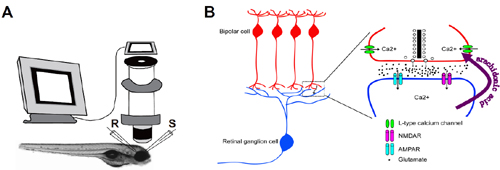Time:2012-08-09
On August 09, 2012, Dr. Jiu-lin Du’s research group at the Institute of Neuroscience, Chinese Academy of Sciences, published a research article entitled “Activity-Induced Long-Term Potentiation of Excitatory Synapses in Developing Zebrafish Retina In Vivo” in Neuron. This work was mainly carried out by graduate student Hongping Wei and colleagues, under the supervision of Dr. Jiu-lin Du.
Activity-induced long-term potentiation (LTP) of synaptic transmission is believed to be one of the cellular mechanisms underlying experience-dependent refinement of neural circuits during development, as well as learning and memory. Although it is well-established that visual experience and neural activity are critical for the refinement of retinal circuits, whether LTP exists in the retina remains unknown.
Using in vivo whole-cell recording and two-photon calcium imaging, this study by Dr. Du’s research group showed that repeated electrical and visual stimulations can induce LTP at excitatory synapses formed by bipolar cells onto retinal ganglion cells, in larval but not juvenile zebrafish. They found that the LTP induction required the activation of postsynaptic N-methyl-D-aspartate receptors, while its expression involved arachidonic acid-dependent presynaptic changes in calcium dynamics and neurotransmitter release. Physiologically, both electrical and visual stimulation-induced LTP can enhance visual responses of retinal ganglion cells. Thus, LTP exists in developing retinae with a presynaptic locus and may serve as a basis for visual experience-dependent refinement of retinal circuits. These findings provide the first evidence for the existence of LTP in the retina, as well as insights into its mechanism and physiological function.
This work was supported by the grants from Ministry of Science and Technology of China, Chinese Academy of Sciences, Shanghai Municipal Government, and State Key Laboratory of Neuroscience.

(A) Diagram of the experimental setup, depicting in vivo perforated whole-cell recording in zebrafish larva retina. R, recording electrode; S, extracellular stimulation electrode.
(B) Working model.
 附件下载:
附件下载: